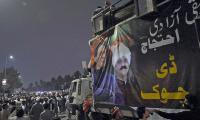Education is a topic on which academia, development experts and the media in Pakistan only ever report doom and gloom.
However, in a recent briefing titled ‘Pakistan is home to the most frenetic education reforms in the world’ (January 4, 2018), The Economist claimed that education reforms in the country are happening at a pace that is “hardly seen anywhere in the world”–something other developing countries could learn from.
Despite the likely local scepticism, The Economist has got it right. As a former partner at a leading global consulting firm, I spent almost all my time leading work on public sector reforms, especially on education, in a number of developing countries. In Pakistan, I led the Roadmap Team that helped UK’s Department for International Development (DfID) and the government of Punjab to design and implement primary education reforms in the province for six-plus years since September 2011.
In addition, I closely observed the education reforms in Khyber Pakhtunkhwa, which were also supported by the DFID. I can therefore vouch for how government education in these two provinces has changed significantly for the better over this period.
This is not to imply that schools in either province are now anywhere near the desired standard. It just suggests that they have improved a great deal from a very low base. Our social sector has been neglected for so long that, regardless of the effort that any government makes, there will always be much more that can be done.
Nevertheless, what has happened is an achievement worth celebrating for various reasons. First, it proves that if we use the right resources and capabilities to address our country-level problems, we can make real progress – and, that too, quickly. Second, it shows that by recognising rather than writing off the good work done by politicians and administrators, we encourage them to do more.
So, what has changed? A number of things in both Punjab and KP. Ghost schools have been almost completely eliminated; teacher and student attendance rates have gone up significantly; and basic facilities (toilets, drinking water, boundary walls and electricity) are now widely available. There is a functioning and reasonably independent monitoring system in place and the management now visits schools and feels more accountable. Budgets are increasing and a larger proportion of the budget is actually spent. The recruitment of teachers is now merit-based and conducted through an independent test administered by the National Testing Service (NTS).
In Punjab, where I have been more deeply involved, the education system is now prioritising learning – at least to the extent of improving basic literacy and numeracy at primary schools. When we started working on the project, an independent survey showed that 50 percent of students in grade five could not do a simple computation and three out of four children could not read a simple sentence in English or Urdu. This is now changing.
Textbooks have improved and are backed by good remedial learning material. Literacy and numeracy hours have been instituted and are conducted in every school every week. The minimum number of teachers at any school has been increased from two to four, which will largely eliminate multi-grade teaching. There is now a culture of practice in classrooms, with autonomous monitors testing 300,000 students on a monthly basis.
Finally, all these changes are backed by an independent six-monthly test to measure progress, which falls completely out of the government’s remit. All these measures are working. Results have shown that basic literacy and numeracy outcomes have moved up by more than 10 percentage points over the past few years.
Many factors have been critical to the success of the education reforms in Pakistan. If properly understood and replicated, these factors can offer a new blueprint to transform large, complex problems in developing countries.
The first factor was the presence of a strong and committed leadership. Interestingly, the leadership models within Punjab and KP varied significantly. In Punjab, leadership came primarily from the chief minister while in KP the broad involvement of a number of stakeholders – including the chief minister, the education minister and the elementary education department – helped take action on Imran Khan’s vision of transforming education. Although very different in nature, both models have proved to be successful. This suggests that reform needs some form of leadership or champion. But the shape this leadership takes can differ. As long as some leadership is available, a successful reform effort can be shaped accordingly.
The second factor was the deliberate push that we made to get the government to ruthlessly focus and prioritise these issues. Typically, reform plans within the government tried to solve every problem under the sun and had little to show in terms of their impact. As an example, let’s consider the five-year plans, the vision documents, growth strategies and bureaucratic sector plans that are gathering dust in government offices or hard drives.
Through Punjab’s School Reforms Roadmap, we always directed the government’s focus towards a few priorities only, which then became mandatory to achieve. In the first phase, we focused on student and teacher attendance and facilities. In the second, an improvement in quality inputs, such as textbooks, was given priority. In the third phase, the emphasis was on a significant push to improve basic literacy and numeracy. As a result, much of what we had aspired for has been achieved.
The third factor was that we sometimes ignored the views of experts. Since Pakistan is currently engaged in efforts to develop various sectors, including education, there were and are a large number of distinguished economists, academics and development experts in the country who offer bad news on almost every topic under the sun. However, only a few are keen on implementation.
While these experts were always available to identify the problems with the education sector in Pakistan, it was a challenge to get actionable advice from many of them. To an extent, their livelihoods depended on sounding alarm bells. In their place, the reform efforts focused on doing what was rapidly ‘doable’ or what the respective governments were willing to put their political capital behind.
To be continued
The writer led the Roadmap Team that helped design and implement education reforms in Punjab from September 2011 to November 2017.
Email: tkhan.mba2008@london.edu
Data, today, defines how we make decisions with tools allowing us to analyse experience more precisely
But if history has shown us anything, it is that rivals can eventually unite when stakes are high enough
Imagine a classroom where students are encouraged to question, and think deeply
Pakistan’s wheat farmers face unusually large pitfalls highlighting root cause of downward slide in agriculture
In agriculture, Pakistan moved up from 48th rank in year 2000 to an impressive ranking of 15th by year 2023
Born in Allahabad in 1943, Saeeda Gazdar migrated to Pakistan after Partition







